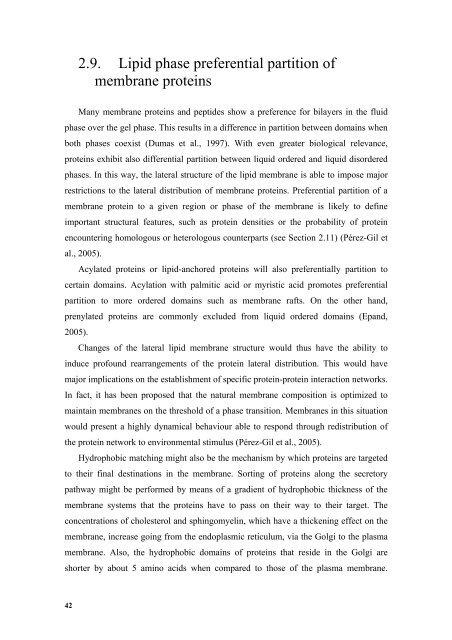Biophysical studies of membrane proteins/peptides. Interaction with ...
Biophysical studies of membrane proteins/peptides. Interaction with ...
Biophysical studies of membrane proteins/peptides. Interaction with ...
You also want an ePaper? Increase the reach of your titles
YUMPU automatically turns print PDFs into web optimized ePapers that Google loves.
2.9. Lipid phase preferential partition <strong>of</strong><br />
<strong>membrane</strong> <strong>proteins</strong><br />
Many <strong>membrane</strong> <strong>proteins</strong> and <strong>peptides</strong> show a preference for bilayers in the fluid<br />
phase over the gel phase. This results in a difference in partition between domains when<br />
both phases coexist (Dumas et al., 1997). With even greater biological relevance,<br />
<strong>proteins</strong> exhibit also differential partition between liquid ordered and liquid disordered<br />
phases. In this way, the lateral structure <strong>of</strong> the lipid <strong>membrane</strong> is able to impose major<br />
restrictions to the lateral distribution <strong>of</strong> <strong>membrane</strong> <strong>proteins</strong>. Preferential partition <strong>of</strong> a<br />
<strong>membrane</strong> protein to a given region or phase <strong>of</strong> the <strong>membrane</strong> is likely to define<br />
important structural features, such as protein densities or the probability <strong>of</strong> protein<br />
encountering homologous or heterologous counterparts (see Section 2.11) (Pérez-Gil et<br />
al., 2005).<br />
Acylated <strong>proteins</strong> or lipid-anchored <strong>proteins</strong> will also preferentially partition to<br />
certain domains. Acylation <strong>with</strong> palmitic acid or myristic acid promotes preferential<br />
partition to more ordered domains such as <strong>membrane</strong> rafts. On the other hand,<br />
prenylated <strong>proteins</strong> are commonly excluded from liquid ordered domains (Epand,<br />
2005).<br />
Changes <strong>of</strong> the lateral lipid <strong>membrane</strong> structure would thus have the ability to<br />
induce pr<strong>of</strong>ound rearrangements <strong>of</strong> the protein lateral distribution. This would have<br />
major implications on the establishment <strong>of</strong> specific protein-protein interaction networks.<br />
In fact, it has been proposed that the natural <strong>membrane</strong> composition is optimized to<br />
maintain <strong>membrane</strong>s on the threshold <strong>of</strong> a phase transition. Membranes in this situation<br />
would present a highly dynamical behaviour able to respond through redistribution <strong>of</strong><br />
the protein network to environmental stimulus (Pérez-Gil et al., 2005).<br />
Hydrophobic matching might also be the mechanism by which <strong>proteins</strong> are targeted<br />
to their final destinations in the <strong>membrane</strong>. Sorting <strong>of</strong> <strong>proteins</strong> along the secretory<br />
pathway might be performed by means <strong>of</strong> a gradient <strong>of</strong> hydrophobic thickness <strong>of</strong> the<br />
<strong>membrane</strong> systems that the <strong>proteins</strong> have to pass on their way to their target. The<br />
concentrations <strong>of</strong> cholesterol and sphingomyelin, which have a thickening effect on the<br />
<strong>membrane</strong>, increase going from the endoplasmic reticulum, via the Golgi to the plasma<br />
<strong>membrane</strong>. Also, the hydrophobic domains <strong>of</strong> <strong>proteins</strong> that reside in the Golgi are<br />
shorter by about 5 amino acids when compared to those <strong>of</strong> the plasma <strong>membrane</strong>.<br />
42















